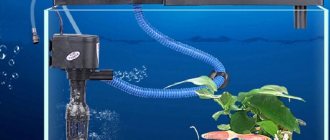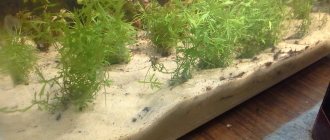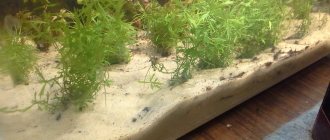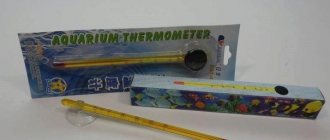Restarting an aquarium is a procedure that almost every aquarist encounters when keeping fish. There can be many reasons for carrying out general cleaning and re-establishing biological balance in a reservoir. The most common are mass death of fish, rapid growth of algae and violation of the tightness of the seams of the container. The restart procedure is similar to the procedure for starting an artificial reservoir from scratch, but it also has some differences.
Possible reasons
A healthy reservoir with a stable biological equilibrium does not need to be restarted. A restart is necessary in the following cases:
- with severe turbidity of the water, which cannot be eliminated by water changes and filtration;
- with rapid growth of algae in water, on glass, decorations and plants;
- when the soil becomes acidic;
- if desired, change the internal design;
- when the tightness of the seams is broken and leaks appear;
- after the death of fish from infection, parasitic infestation or poisoning.
Restart instructions
Restarting an aquarium is a long undertaking that every aquarist should be prepared for. It consists of many steps, none of which should be skipped:
First you need to remove all the inhabitants from the aquarium. The fish are transplanted into special small containers of several individuals. Water can be added to the fish tanks from the aquarium, but only if the reason for the restart was not a change in its parameters. If the medium turns out to be spoiled or unsafe, the fish are placed in settled tap water (it is recommended to keep it for 2-3 days to reduce hardness). Next, a filter, heater and lighting are installed in temporary housing. The main task for this period is to completely recreate normal living conditions for each individual.
Aquarium plants must also be removed from the pond. This must be done with special care so as not to damage the root system. Representatives of the flora are also placed in nurseries with water parameters as close as possible.
Next, all decorative items are removed from the pond. They need to be washed with a stiff brush in a soda solution, then rinsed under running water, treated with a disinfectant solution (for example, chlorheskidine or hydrogen peroxide) and rinsed again. The decorations are then left to dry.
After this, you need to treat the soil. It is completely removed from the aquarium and washed under running water. Next, the washed soil is placed in the oven and calcined at a temperature of 200°C for 30 minutes for precise disinfection.
Once the tank is completely empty, you need to clean it thoroughly. The empty container is washed with a solution of soda in warm water. It can be replaced with special detergents. But it is important to purchase them only from pet stores, because ordinary household solutions contain a large amount of chemicals. It is advisable to use a soft sponge, which will not leave scratches on the glass, but will effectively clean them.
If the reason for updating the aquarium was due to problems in the design of the aquarium, then it should be carefully inspected for leaks or cracks. If repairs are necessary, be sure to use only special aquarium sealants.
The restart process ends with the repopulation of the aquarium and the restoration of its previous ecosystem. To do this you need:
- Prepare water within 2-3 days.
- Place washed and dried soil on the bottom.
- Fill it 20-30 cm with settled water.
- Place the plants in the substrate.
- Set up decorations and connect equipment.
- Fill the rest of the tank with water.
- Conduct tests on the quality of the environment, and, if the norm for all indicators is determined, release the fish into the reservoir.
- If at least one water parameter deviates from the norm, then it must be adjusted.
How to restart an aquarium
Restarting the aquarium involves first of all a general cleaning by draining the water and cleaning all internal surfaces, including the soil, decorations and equipment. The second stage is the launch of a new ecosystem in the old volume. This process is quite labor-intensive, so it should be carried out in several steps.
Relocating the inhabitants
To carry out general cleaning, it is necessary to remove all inhabitants from the aquarium. The fish are transplanted into a separate container of sufficient volume. If the water in the aquarium is not spoiled, it is poured into a fish tank. If the reason for the restart was a violation of water parameters, settled tap water is used to replant the fish. You can add water that has been passed through a reverse osmosis system. To prepare the environment, you can use a special aquarium conditioner. After transplanting aquatic organisms, a heater, a sprayer and, if necessary, a filter are installed in the aquarium. Conditions are maintained at the level familiar to the fish.
Aquarium plants are carefully removed from the soil, trying not to damage the root system, and transferred to a separate container. The same water is poured into it as into the fish tank. Other hydrobionts (molluscs, crustaceans) are also transplanted into a temporary container with suitable environmental parameters.
Cleaning the soil and decorations
The soil is removed from the container and washed under running water. It is convenient to use a colander or sieve for this. Thoroughly washed soil is calcined in the oven at 200°C for 30 minutes. The decorations are washed under running water and cleaned with a stiff brush and soda. After cleaning, rinse them several times in clean water.
My aquarium
The walls and bottom of the artificial reservoir are washed with warm water. You can add soda to it. Plaque and algae are removed using a sponge or a special scraper. Then the container is rinsed and wiped dry with a clean soft cloth.
If the reason for the restart was a leak, the glass and seams are inspected to identify the location of the leak and the aquarium is repaired. To check reliability, fill the container with water and leave for 1-2 hours. If no leaks are detected, the water is drained and the aquarium is started.
Starting an aquarium
Soil is placed at the bottom of the container and covered with a 15-20 cm layer of settled water. The plants are taken out of the nursery, washed with warm water and planted in the substrate. Then the decorations and equipment are installed. The devices are turned on and checked for proper operation. The volume is filled with water and tested for basic indicators. If they are within normal limits, the aquarium inhabitants are released.
On a note! In the first days after launch, it is necessary to monitor the condition of fish and plants. It is advisable to monitor water parameters daily. A week after launch, you need to change 10% of the water. Then they switch to the regular replacement schedule.
When is it necessary to restart the aquarium?
The restart process is practically no different from the initial startup of the aquarium. The only thing that should be done additionally is complete cleaning and disinfection of the container and its contents, since a restart is often caused by a bacterial or infectious outbreak.
There is an opinion that a complete restart of the aquarium must be performed at certain intervals, carrying out “general cleaning”, regardless of the condition of the aquatic system. This is a misconception that should not be adhered to. Restarting is extremely stressful for all the inhabitants of the aquarium, and if their lives are not in danger, then there is absolutely no point in exposing the animals to shock.
Reasons why an aquarium is restarted:
- Muddy water and overgrown walls. If regular water changes and filtration do not change the situation, restarting the aquarium will help get rid of this problem;
- Soil acidification and inability to properly clean it;
- In the presence of fungal, infectious or viral infections, where healthy pets are at risk;
- Changing the design of the aquarium will also require a restart;
- In the presence of cracks, leaks and other technical reasons.
The reason for the restart may be cloudy water in the aquarium.
Restarting after fish illness
If there is a massive death of fish in an aquarium due to a disease, it is necessary to catch the surviving aquatic organisms as soon as possible, transplant them into a quarantine aquarium and begin treatment. Settled water is poured into the fish tank with parameters suitable for the fish.
Restarting an aquarium after a fish illness should begin with removing contaminated water and thoroughly washing the soil, decorations and glass. If the disease as a result of which the fish died is infectious, the aquarium will need to be disinfected. If the disease is caused by parasites, there is no need to use special drugs to destroy them: in the absence of their hosts, they will quickly die on their own. Therefore, in case of parasitic infestations, the main measures to eliminate them are to replace 40-80% of the water, clean the filter and move the fish to the fish tank for 15 days. Once the diseased fish are cured, they can be replanted.
Start of the process
Before you proceed directly to restarting the aquarium, you need to take care of moving its inhabitants to a suitable environment. To do this, you should purchase a spare aquarium. It is filled with old water, if it is suitable for use, or new water. Distilled or settled water of the required temperature (optimal for fish) is suitable. Aquascapers with extensive experience say that high-quality filtering devices must be installed in a temporary container, plus the liquid must sit for at least eight hours. After this, the fish are released into this prepared water and remain under observation.
Restart with disinfection
Restarting the aquarium with disinfection is necessary in case of infection of fish or plants. The inhabitants of the aquarium are moved to a quarantine tank and treated. The water from the aquarium is drained and the volume is filled with a mixture of water and washing powder (400 g per 30 l). The glass is thoroughly washed, and then the detergent is washed off several times with warm water. The aquarium is filled with clean water and left for a day. Then the water is drained.
Decorative elements and equipment are also washed in a solution of washing powder. Then they are rinsed and soaked for a day in clean water. The soil is washed in running water and calcined in the oven for 30 minutes.
Plants are disinfected using a penicillin solution. To prepare it, take 50 g of the drug and stir it in 10 liters of water. This composition is poured into a container of a suitable size and the plants are moved there. Treatment is carried out within a week. The water temperature is maintained at 25°C. Every day part of the solution is replaced with fresh one.
The most important step is tidying up the aquarium
Cleaning the aquarium itself should be done slowly and very carefully. The best place to wash a glass vessel is the bathroom. There, every centimeter of the walls is washed with hot water with a sponge, paying special attention to the corners (if the container is not round). And so several times, the last time - under running water without a sponge. Chemical cleaning agents are not recommended unless absolutely necessary. But then you will have to wash it repeatedly.
Thoroughly blot all walls with a clean cloth and remove all defects.
But to make sure that everything is in order, water is poured into the container, left for three to four hours and then drained. The aquarium is completely dried from moisture - you can use a hairdryer to remove any remaining moisture.











